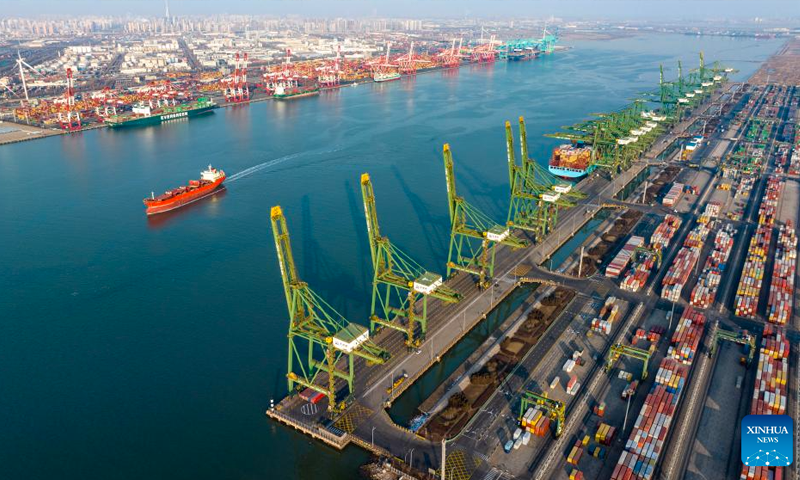
An aerial drone photo taken on Feb 2, 2024 shows a cargo ship sailing in the main channel of Tianjin Port in north China's Tianjin. Tianjin Port, located on the coast of the Bohai Sea, is a major shipping point in north China. Photo: Xinhua
Multiple Chinese ports reported increased throughput in January, marking a strong start for the year. As an important economic indicator, port operations showcase the robustness of China's production activity and foreign trade, and the ports play a significant role in maintaining the stability of the global supply chain, experts said.
The Port of Guangzhou in South China's Guangdong Province said cargo throughput was up 16.4 percent and container throughput up 29.3 percent in January, both on a year-on-year basis, making positive contributions to stabilizing foreign trade and facilitating logistics.
The number of foreign ship arrivals and container throughput for foreign trade both rose more than 20 percent year-on-year, the Global Times learned from the port on Wednesday.
Beibu Gulf Port, in South China's Guangxi Zhuang Autonomous Region, handled 25.83 million tons of cargo in January, up 8.45 percent. As the closest Chinese port to ASEAN, it plays a crucial role in trading with those countries with 35 routes.
Rizhao Port in East China's Shandong Province said cargo turnover grew 6.4 percent year-on-year in January, a new record. The efficiency of container ships used for foreign trade was up 60 percent.
The robust operation of major Chinese ports reflected a stable economic outlook at the beginning of the year, a crucial period for sustaining production and economic activity, experts said.
The figures from these ports reflect the positive production situation in China and stable logistics, Cong Yi, a professor at the Tianjin University of Finance and Economics, told the Global Times on Wednesday.
China's logistics industry improved in 2023, with its value reaching 352.4 trillion yuan ($49.56 trillion), up 5.2 percent. The growth rate was accelerated by 1.8 percentage points from 2022, according to data from the China Federation of Logistics & Purchasing on Wednesday.
The Chinese logistics system plays a crucial role in ensuring the smooth functioning of the global logistics network, particularly during times of disruption in the Red Sea, experts said.
It shows that Chinese ports are operating well and have high efficiency in loading and unloading. If there is foreign demand for Chinese goods, China should be able to fully guarantee the international supply chain, Zheng Ping, chief analyst with industry news portal chineseport.cn, told the Global Times on Wednesday.
The port data also indicated that China's foreign trade in January may have exceeded expectations, Tian Yun, a veteran economist based in Beijing, told the Global Times on Wednesday.
Full confirmation will have to wait for the February data, as typically the first two months are reported together due to the Spring Festival holidays, Tian added.
China's foreign trade grew 0.2 percent in 2023, a "hard-won achievement" amid headwinds.
According to a survey conducted by the General Administration of Customs on key import and export enterprises, over three-quarters of those surveyed expected their imports and exports to remain stable or grow this year.
Despite sluggish external demand and uncertainties such as trade protectionism and geopolitical conflicts, China's economy has strong resilience, great potential and a vibrant market.
With its significant production capacity and market advantage, China is confident and capable of promoting its foreign trade this year, Wang Lingjun, a vice minister of the General Administration of Customs, told a press conference in January.
If foreign trade significantly rebounds and consumer spending continues to maintain a growth rate of about 6 percent, China's economic growth in the first quarter may exceed 5 percent, Tian said.




